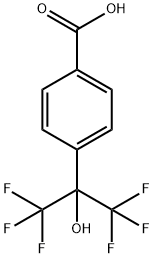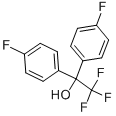(S)-(+)-ALPHA-(TRIFLUOROMETHYL)BENZYL ALCOHOL
Synonym(s):(+)-Phenyl(trifluoromethyl)carbinol;(S)-(+)-1-Phenyl-2,2,2-trifluoroethanol
- CAS NO.:340-06-7
- Empirical Formula: C8H7F3O
- Molecular Weight: 176.14
- MDL number: MFCD00077845
- EINECS: 206-430-7
- SAFETY DATA SHEET (SDS)
- Update Date: 2023-06-08 17:06:39

What is (S)-(+)-ALPHA-(TRIFLUOROMETHYL)BENZYL ALCOHOL?
The Uses of (S)-(+)-ALPHA-(TRIFLUOROMETHYL)BENZYL ALCOHOL
(S)?-?(+)?-?α-?(Trifluoromethyl)?benzyl Alcohol is used in the synthesis of metal-organic framework compounds which may have mesoporous properties.
Purification Methods
Purify the chiral alcohols by fractional distillation preferably in a vacuum. [Morrison & Ridgeway Tetrahedron Lett 573 1969, NMR: Pirkle & Beare J Am Chem Soc 90 6250 1968.] The racemate [340-05-6] has b 52-54o/2mm,57-59o/2mm, 64-65o/5mm, d 4 20 1.293, n D 20 1.457, and the 2-carbobenzoyl derivative has m 137-138o [Mosher et al. J Am Chem Soc 78 4374 1956]. [Beilstein 6 IV 3043.]
Properties of (S)-(+)-ALPHA-(TRIFLUOROMETHYL)BENZYL ALCOHOL
| Boiling point: | 73-76 °C9 mm Hg(lit.) |
| Density | 1.3 g/mL at 25 °C(lit.) |
| refractive index | n |
| Flash point: | 184 °F |
| storage temp. | Inert atmosphere,Room Temperature |
| form | Liquid |
| pka | 11.91±0.10(Predicted) |
| color | Clear colorless to pale yellow |
| optical activity | [α]20/D +31.3±0.5°, neat |
| BRN | 2327547 |
Safety information for (S)-(+)-ALPHA-(TRIFLUOROMETHYL)BENZYL ALCOHOL
| Signal word | Warning |
| Pictogram(s) |
 Exclamation Mark Irritant GHS07 |
| GHS Hazard Statements |
H315:Skin corrosion/irritation H319:Serious eye damage/eye irritation H335:Specific target organ toxicity, single exposure;Respiratory tract irritation |
| Precautionary Statement Codes |
P261:Avoid breathing dust/fume/gas/mist/vapours/spray. P264:Wash hands thoroughly after handling. P264:Wash skin thouroughly after handling. P271:Use only outdoors or in a well-ventilated area. P280:Wear protective gloves/protective clothing/eye protection/face protection. P302+P352:IF ON SKIN: wash with plenty of soap and water. P305+P351+P338:IF IN EYES: Rinse cautiously with water for several minutes. Remove contact lenses, if present and easy to do. Continuerinsing. |
Computed Descriptors for (S)-(+)-ALPHA-(TRIFLUOROMETHYL)BENZYL ALCOHOL
New Products
Tert-butyl bis(2-chloroethyl)carbamate (S)-3-Aminobutanenitrile hydrochloride N-Boc-D-alaninol N-BOC-D/L-ALANINOL N-octanoyl benzotriazole 4-Hydrazinobenzoic acid 3,4-Dibenzyloxybenzaldehyde 3-Nitrobenzaldehyde 1,1’-CARBONYLDIIMIDAZOLE R-2-BENZYLOXY PROPIONIC ACID 1,1’-CARBONYLDI (1,2-4 TRIAZOLE) 4-HYDROXY BENZYL ALCOHOL 3-NITRO-2-METHYL ANILINE (2-Hydroxyphenyl)acetonitrile 5-BROMO-2CYANO PYRIDINE 5,6-Dimethoxyindanone 5-broMo-2-chloro-N-cyclopentylpyriMidin-4-aMine 2-(Cyanocyclohexyl)acetic acid 4-methoxy-3,5-dinitropyridine 2-aminopropyl benzoate hydrochloride 1-(4-(aminomethyl)benzyl)urea hydrochloride tert-butyl 4- (ureidomethyl)benzylcarbamate diethyl 2-(2-((tertbutoxycarbonyl)amino) ethyl)malonate Ethyl-2-chloro((4-methoxyphenyl)hydrazono)acetateRelated products of tetrahydrofuran








You may like
-
 (S)-(+)-α-(Trifluoromethyl)benzyl Alcohol CAS 340-06-7View Details
(S)-(+)-α-(Trifluoromethyl)benzyl Alcohol CAS 340-06-7View Details
340-06-7 -
 (S)-(+)-α-(Trifluoromethyl)benzyl alcohol CAS 340-06-7View Details
(S)-(+)-α-(Trifluoromethyl)benzyl alcohol CAS 340-06-7View Details
340-06-7 -
 55441-95-7 99%View Details
55441-95-7 99%View Details
55441-95-7 -
 N-Vinylformamide 99%View Details
N-Vinylformamide 99%View Details
13162-05-5 -
 Chloro Uracil 1820-81-1 99%View Details
Chloro Uracil 1820-81-1 99%View Details
1820-81-1 -
 2-ethyl-6-methyl-3-hydroxypyridine succinate 99%View Details
2-ethyl-6-methyl-3-hydroxypyridine succinate 99%View Details
127464-43-1 -
 2-ETHYLPYRIDINE 100-71-0 99%View Details
2-ETHYLPYRIDINE 100-71-0 99%View Details
100-71-0 -
 181228-33-1 (S)-Methyl 3-amino-2-((tert-butoxycarbonyl)amino)propanote Hydrochloride (DAP-OMe. HCl) 99%View Details
181228-33-1 (S)-Methyl 3-amino-2-((tert-butoxycarbonyl)amino)propanote Hydrochloride (DAP-OMe. HCl) 99%View Details
181228-33-1
Statement: All products displayed on this website are only used for non medical purposes such as industrial applications or scientific research, and cannot be used for clinical diagnosis or treatment of humans or animals. They are not medicinal or edible.